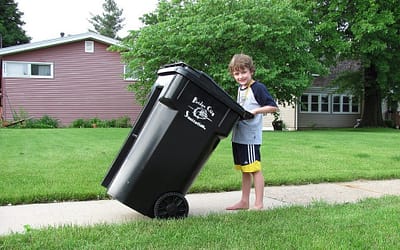How to Create & Maintain an Eco-friendly Online Presence
It’s easy to think that switching to remote work, saving files digitally, and cloud-based data storage are all greener than traditional office activities.
It’s vital to take a step back and think again. Often, our quick judgement of an activity being internet-based is overwhelmingly positive.
Online usage, from a website presence to data storage, all impact the environment in some way or another. In an increasingly interconnected globe, there are two key points to consider.
The first is to understand the environmental impact of our digital presence. The second is to understand and implement approaches to minimize our impact. We must ensure that we are building a greener future with every online initiative we collectively take.
The Internet at Glance
As with many exploratory human endeavors, the excitement of the internet, world wide web, and subsequent .com explosion, the environmental cost wasn’t scrutinized at first.
The marvel at our human ingenuity trumped the concern for a more eco-friendly world. Decades later, the climate change discussions and initiatives are front and center.
Not only that, but these topics are posed on the global stage that is the internet. The internet itself and its impacts can still be misunderstood. There are a variety of factors that play into the carbon footprint left by online activity.
First, there is the device of the user, which was mass-produced somewhere and takes recharging to function. Understandably, this consumes energy and resources.
Second, there’s the infrastructure that maintains the interconnectedness of the internet: deep sea cables, satellites, data centers, and their power sources, each with their own carbon footprint.
Third, there is the carbon footprint of everything we do online, every website visit, email sent and received, streaming activity, and social media interaction.
That information must be transferred to the relevant server to continue on and be properly transmitted. This consumes energy and leaves a mark as well. Every step taken on a simple day online has it’s impact.
The Impact
Studies regarding the internet’s overall environmental impact vary, some estimates place the internet’s carbon footprint at 3.7% of total emissions – that’s on par with the aviation industry.
According to the BBC, “if every adult in the UK sent one less “thank you” email, it could save 16,433 tons of carbon a year – the equivalent of taking 3,334 diesel cars off the road.” As for search engines, it’s worth noting that although Google is doing quite a bit to mitigate their impact.
However, according to The Atlantic, Google still uses as much electricity annually as the entire country of Turkey.
In a 2012 sustainability report, it was revealed that Facebook and its data centers use 986 million kilowatt-hours of electricity. That’s approximately the same amount used by the entire country of Burkina Faso in 2012.
Data centers are certainly a large part of the internet’s overall environmental impact. They must be maintained under very specific cooling conditions to function properly.
Surprisingly, around 40% of the total energy used by a data center is dedicated to cooling IT equipment. These coolants aren’t eco-friendly, they’re produced with hazardous chemicals and the production itself is damaging to the environment.
Shirting to a more micro-level impact, consider how many emails you send a day. According to Ovo Energy, each email you send amounts to an average of 1g of carbon emission.
To contextualize this, that’s about the same weight as a teaspoon of sugar or a paperclip. It may not seem like much, but multiply that by your daily email habits, your co-workers, your company’s, your industry’s, and everyones. It all adds up.
Streaming is yet another activity undertaken by many that greatly impacts the environment. A study conducted by the University of Bristol in 2016 estimated that Youtube videos streamed over the course of a year resulted in 11.13 million tons of carbon dioxide. This highlights the importance of two vital steps that must be taken.
Both tech companies and consumers must be cognizant of their impact and do everything, whether that’s switching to green data centers or watching less Netflix, to help create a more eco-friendly world.
Practical Implementation for Individuals
Tips from Ovo Energy on ways to reduce your digital footprint:
- Shut down your computer when you’re done using it
- Downsize your gadgets if possible
- If you use cloud storage, see how the data center is powered
- Use a green search engine such as Ecosia, profits generated from searches plant trees!
- Think before hitting “send” or “comment”, is “ok, thanks!” really worth the energy consumption?
Practical Implementation for Website
- Create your website on a eco-friendly hosting platform, check out a list here
- Keep it simple & minimal; avoid graphics, videos, and/or photos to use less energy on your site
- Check which data center(s) are being used by your website: From there, you can determine how they power their data center (with fossil fuels or clean energy). If they use non-renewable resources or harmful coolant, consider switching to a cleaner data center
- Calculate your website’s carbon footprint here
- Check out this free website health test
- Draw from inspiration around you, Komoneed (where you’re reading this article) being a great example of a green but attractive website
Weigh the Options
In light of all this information, take a moment to consider the following:
- Is it absolutely necessary that I send that short email, write that text, watch that video, or like that photo?
- Am I using a clean, green search engine? If not, what’s stopping me?
- Am I charging my devices with clean energy?
Sources
- A short history of the Web | CERN (home.cern)
- 50 Years Ago, the First Internet Message Was Dispatched from UCLA (lamag.com)
- The Internet’s environmental impact & how you can help (erjjiostudios.com)
- Celebrating the Web@30 | timeline.web.cern.ch
- History of the Web – World Wide Web Foundation
- The Environmental Impact of the Data-Center Industry – The Atlantic
- What impact are data centres having on climate change? | Computerworld
- How to reduce the environmental impact of your next virtual meeting | MIT News | Massachusetts Institute of Technology
- What is Your Online Carbon Footprint and How to Reduce it? | OVO Energy
- Amazon, Google, Microsoft: Here’s Who Has the Greenest Cloud | WIRED
- Ecosia – the search engine that plants trees
- How to Calculate Your Carbon Footprint: OVO Greenlight | OVO Energy
- Lean-ICT-Report_The-Shift-Project_2019.pdf (theshiftproject.org)
- Why your internet habits are not as clean as you think – BBC Future
- Lean-ICT-Report_The-Shift-Project_2019.pdf (theshiftproject.org)
- Website performance and environmental impact (st-andrews.ac.uk)
- The alarming environmental impact of the Internet | Medium
- Greening the Web: How We Can Create Zero Carbon Websites (kinsta.com)
- Website Health Check | erjjio studios
- Greenpeace Report: Click Clean Virginia – Greenpeace USA
- 7 Best Green Web Hosting Providers (websitebuilderexpert.com)
- Komoneed
Image
- Pixabay





I am absolutely shocked about this fact mentioned in the article: The internet’s carbon footprint makes of for 3.7% of total emissions!
This is crazy and all of us should start questioning our daily addiction to the internet as well!
Yes!… Sometimes, we are not paying attention to this kind of things… And those are things that we are able change it ASAP
Thanks for sharing the free website health test in this article! All of us should at least be aware about the side effects our website can cause and introduce changes from there.
Thank you very much Claus! Together we can make a deep change!
It’d be fascinating if each website assessed its environmental footprint and published it – the figures would most likely be shocking..
Yes! It would be shocking… The question is, who would reduce the efforts to obtain more visits -and develop business- to their website?